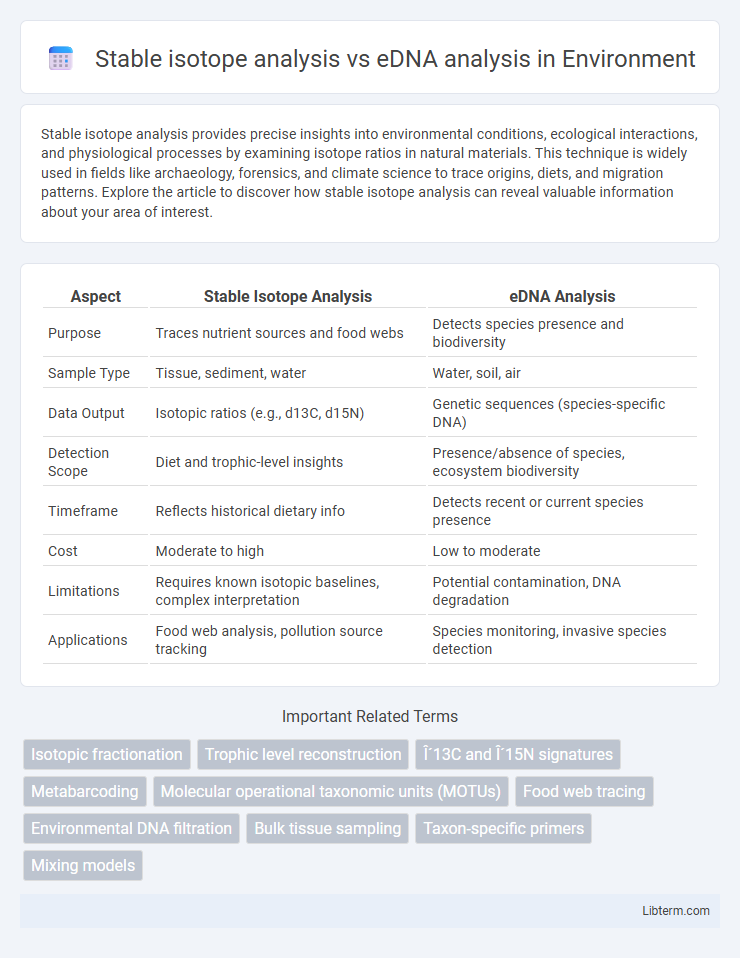Stable isotope analysis provides precise insights into environmental conditions, ecological interactions, and physiological processes by examining isotope ratios in natural materials. This technique is widely used in fields like archaeology, forensics, and climate science to trace origins, diets, and migration patterns. Explore the article to discover how stable isotope analysis can reveal valuable information about your area of interest.
Table of Comparison
| Aspect | Stable Isotope Analysis | eDNA Analysis |
|---|---|---|
| Purpose | Traces nutrient sources and food webs | Detects species presence and biodiversity |
| Sample Type | Tissue, sediment, water | Water, soil, air |
| Data Output | Isotopic ratios (e.g., d13C, d15N) | Genetic sequences (species-specific DNA) |
| Detection Scope | Diet and trophic-level insights | Presence/absence of species, ecosystem biodiversity |
| Timeframe | Reflects historical dietary info | Detects recent or current species presence |
| Cost | Moderate to high | Low to moderate |
| Limitations | Requires known isotopic baselines, complex interpretation | Potential contamination, DNA degradation |
| Applications | Food web analysis, pollution source tracking | Species monitoring, invasive species detection |
Introduction to Stable Isotope Analysis and eDNA Analysis
Stable isotope analysis measures the ratios of isotopes like carbon-13 and nitrogen-15 in biological samples to trace dietary sources and ecological interactions. Environmental DNA (eDNA) analysis detects genetic material shed by organisms into environments, enabling species identification and biodiversity assessment without direct observation. Both methods provide complementary insights into ecosystem dynamics, with stable isotopes revealing trophic relationships and eDNA capturing species presence from environmental samples.
Fundamental Principles of Stable Isotope Analysis
Stable isotope analysis relies on measuring the ratios of naturally occurring isotopes, such as carbon-13 to carbon-12 or nitrogen-15 to nitrogen-14, within a sample to trace ecological and biochemical processes. This method exploits the predictable fractionation of isotopes during metabolic activities, enabling precise insights into food web dynamics, trophic relationships, and nutrient cycling. Unlike eDNA analysis, which targets genetic material for species identification, stable isotope analysis provides integrative information about the sources and pathways of organic matter over time.
Core Concepts of Environmental DNA (eDNA) Analysis
Environmental DNA (eDNA) analysis detects genetic material shed by organisms into their environment, offering a non-invasive method to monitor biodiversity and detect species presence. Stable isotope analysis measures ratios of isotopes in biological samples to infer trophic relationships and ecological processes, providing information on energy flow and diet over time. eDNA focuses on molecular detection for species identification, while stable isotope analysis emphasizes chemical signatures for ecological interactions.
Methodological Differences: Stable Isotope vs eDNA
Stable isotope analysis measures the ratios of isotopes such as carbon-13 to carbon-12 in biological tissues, providing insights into trophic levels and dietary sources over time. Environmental DNA (eDNA) analysis detects genetic material shed by organisms into the environment, enabling species identification and biodiversity assessment without direct organism sampling. Stable isotope analysis offers temporal dietary integration, while eDNA provides real-time presence/absence data with high taxonomic resolution.
Applications in Ecological and Biodiversity Studies
Stable isotope analysis provides insights into ecological food webs and animal migration patterns by tracing nutrient sources and trophic relationships, offering quantitative data on ecosystem dynamics. eDNA analysis detects species presence and biodiversity by analyzing genetic material in environmental samples, enabling rapid, non-invasive monitoring of rare or elusive species. Combining both methods enhances understanding of ecosystem interactions and biodiversity patterns, supporting conservation efforts and habitat management.
Sensitivity and Specificity in Species Detection
Stable isotope analysis offers broad ecosystem insights but has lower species-level sensitivity compared to eDNA analysis, which detects minute genetic traces with high specificity. eDNA analysis can identify rare or elusive species through targeted DNA sequences, reducing false positives and enhancing species detection accuracy. Sensitivity in eDNA methods surpasses stable isotope analysis, making it ideal for precise biodiversity monitoring and conservation efforts.
Temporal and Spatial Resolution: Comparative Insights
Stable isotope analysis offers insights into temporal dietary patterns by integrating data over weeks to months, providing a long-term view of ecological interactions, while eDNA analysis delivers high spatial resolution by detecting species presence from environmental samples at specific locations in near real-time. Temporal resolution in eDNA is limited due to rapid degradation and turnover of genetic material, whereas stable isotopes reflect accumulated biological signals, enabling retrospective ecological assessments. Combining both methods enhances understanding of spatial distribution dynamics alongside temporal dietary or trophic changes in ecosystem studies.
Strengths and Limitations of Each Approach
Stable isotope analysis excels in tracing nutrient pathways and understanding trophic interactions through elemental composition in tissues, offering insights into long-term ecological processes but lacks species-specific resolution. eDNA analysis provides highly sensitive detection of species presence from environmental samples, enabling rapid biodiversity assessments and early invasion detection, yet it is limited by DNA degradation rates and potential contamination risks. Combining both methods enhances ecosystem monitoring by leveraging stable isotopes' integrative ecological data with eDNA's precise taxonomic identification.
Integrating Stable Isotope and eDNA Analyses
Integrating stable isotope analysis and eDNA analysis enhances ecological research by combining metabolic and genetic information to trace nutrient pathways and species presence accurately. Stable isotope analysis offers insights into trophic interactions and energy flow within ecosystems, while eDNA analysis allows for precise detection of organisms from environmental samples without physical capture. Together, these methods provide a comprehensive understanding of biodiversity, species distribution, and ecological dynamics, supporting more informed conservation strategies.
Future Directions in Ecological Monitoring Technologies
Future directions in ecological monitoring technologies emphasize integrating stable isotope analysis and eDNA analysis to enhance ecosystem assessment accuracy. Stable isotope analysis provides detailed insights into trophic interactions and nutrient cycling, while eDNA analysis offers sensitive detection of biodiversity and species presence. Combining these methods can improve temporal and spatial resolution in monitoring, enabling more comprehensive biodiversity and environmental change assessments.
Stable isotope analysis Infographic

 libterm.com
libterm.com